中西方传统节日文化对比 论文
- 格式:doc
- 大小:134.50 KB
- 文档页数:34
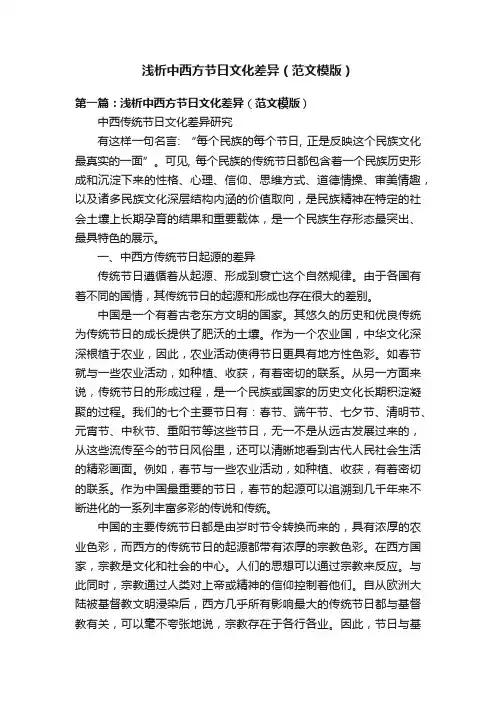
浅析中西方节日文化差异(范文模版)第一篇:浅析中西方节日文化差异(范文模版)中西传统节日文化差异研究有这样一句名言: “每个民族的每个节日, 正是反映这个民族文化最真实的一面”。
可见, 每个民族的传统节日都包含着一个民族历史形成和沉淀下来的性格、心理、信仰、思维方式、道德情操、审美情趣,以及诸多民族文化深层结构内涵的价值取向,是民族精神在特定的社会土壤上长期孕育的结果和重要载体,是一个民族生存形态最突出、最具特色的展示。
一、中西方传统节日起源的差异传统节日遵循着从起源、形成到衰亡这个自然规律。
由于各国有着不同的国情,其传统节日的起源和形成也存在很大的差别。
中国是一个有着古老东方文明的国家。
其悠久的历史和优良传统为传统节日的成长提供了肥沃的土壤。
作为一个农业国,中华文化深深根植于农业,因此,农业活动使得节日更具有地方性色彩。
如春节就与一些农业活动,如种植、收获,有着密切的联系。
从另一方面来说,传统节日的形成过程,是一个民族或国家的历史文化长期积淀凝聚的过程。
我们的七个主要节日有:春节、端午节、七夕节、清明节、元宵节、中秋节、重阳节等这些节日,无一不是从远古发展过来的,从这些流传至今的节日风俗里,还可以清晰地看到古代人民社会生活的精彩画面。
例如,春节与一些农业活动,如种植、收获,有着密切的联系。
作为中国最重要的节日,春节的起源可以追溯到几千年来不断进化的一系列丰富多彩的传说和传统。
中国的主要传统节日都是由岁时节令转换而来的,具有浓厚的农业色彩,而西方的传统节日的起源都带有浓厚的宗教色彩。
在西方国家,宗教是文化和社会的中心。
人们的思想可以通过宗教来反应。
与此同时,宗教通过人类对上帝或精神的信仰控制着他们。
自从欧洲大陆被基督教文明浸染后,西方几乎所有影响最大的传统节日都与基督教有关,可以毫不夸张地说,宗教存在于各行各业。
因此,节日与基督教有着密切的联系,在众多的西方节日里,与基督教有关的占了38个至多,在英语词汇中也有大量的与宗教有关的单词,可见,宗教对于西方文化的影响非常之大。
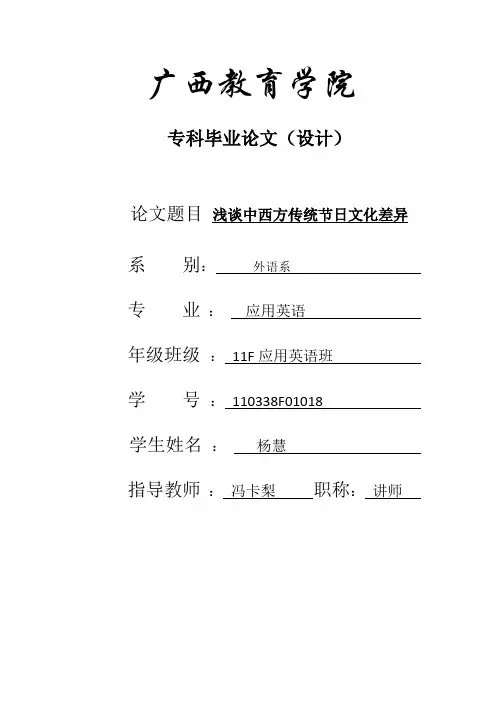
广西教育学院专科毕业论文(设计)论文题目浅谈中西方传统节日文化差异系别:外语系专业:应用英语年级班级:11F应用英语班学号:110338F01018学生姓名:杨慧指导教师:冯卡梨职称:讲师广西教育学院专科毕业论文(设计)任务书课题名称:浅谈中西方传统节日文化差异系别外语系专业应用英语班级应用英语班学号110338F01018姓名杨慧指导教师(签名)__________ 年月日教研室主任(签名)_________ 年月日年月日论文任务书目录浅谈中西方传统节日文化差异 (4)中文摘要 (4)关键词 (4)Abstract (5)Key words (5)一、中西方传统节日的起源与形成的差异 (6)二、中西方传统节日习俗的差异 (7)2、1中国主要传统节日的习俗 (8)2、2西方主要传统节日的习俗 (9)三、中西方传统节日的相互交融 (10)四、结语 (11)参考文献 (12)致谢 (13)浅谈中西方传统节日文化差异摘要传统节日是一个民族发展的历史产物,无论是在有着五千多年悠长历史的中国还是在新生的美国,传统节日的起源都显示出相通之处,大多数传统节日都源自于人们在农业生产生活中对丰收的期盼、对天地神灵和自然的崇拜、以及对历史人物的祭奠等等。
传统节日在长期的演变和发展中,已经成为民族文化不可或缺的一部分,透过传统节日可以反映一个民族的文化特色和民族精神。
同时中国和西方国家的文化存在着各个方面的差异,传统节日文化是其中重要的一项,而中西节日文化也有着各自不同的特点。
节日文化博大精深,各国的节日风俗是约定俗成的,有着各自鲜明的民族特色和丰富多彩的表现形式。
本文从两国传统节日中有着相似文化内涵的节日出发,探讨这些传统节日在起源、节日习俗等方面的差异,并分析产生这些差异的原因,从而折射出两国传统节日文化的差异。
另外本文也探讨了中西方传统节日的相互融合。
关键词:根源传统节日中西文化差异相互融合Culture Differences of Chinese and Western TraditionalFestivalsAbstractTraditional festivals are the historical products of a nation’s development. Whether in China which has a long history of more than five thousand years or in the newborn America, the origination of traditional festivals in the two countries is similar. Most traditional festivals originated from people’s expectation for harvest in the agricultural production, the worship towards the gods and the nature, sacrifices to the historical characters and etc. After the long-term evolution, traditional festivals have become an indispensable part of the national culture. Through traditional festivals, the distinct cultural characteristics of a people and the national spirits can be observed. And there are aspects of differences between Chinese and western cultures. Traditional festivals are one of the important differences, and there are distinctive features exist in Chinese and western festival cultures as well. Festival culture is very profound. The festival customs in dissimilar countries are established by usage, with the own distinct national features and rich presentation forms. This paper is designed to discuss the differences in customs, origins and other aspects of traditional festivals with the similar cultural connotation, then analyze the reasons lying behind the differences and finally reflect the cultural differences of the two nations. The paper also analyzes the mutual fusion in traditional holidays between China and the west.Key words: causes; Traditional festivals; Chinese and western culture;cultural differences; mutual fusion节日是指一年中被赋予特殊社会文化意义并穿插于日常生活之间的日子,是人们丰富多彩生活的集中体现,是各地区、民族、国家的政治、经济、文化、宗教等的总结和延伸。
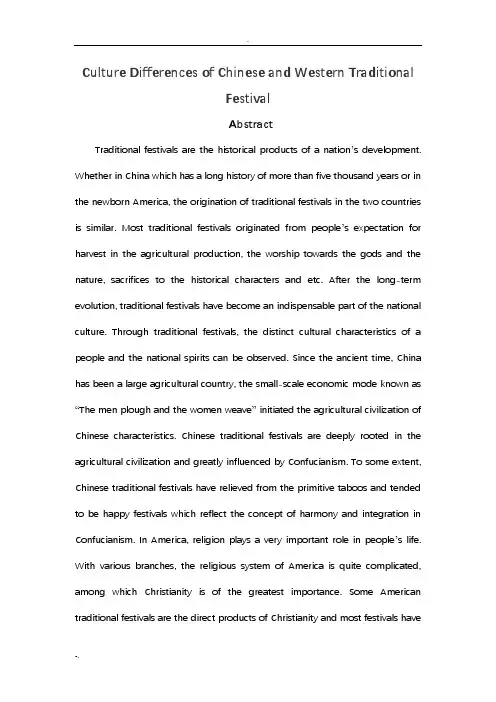
Culture Differences of Chinese and Western TraditionalFestivalAbstractTraditional festivals are the historical products of a nation’s development. Whether in China which has a long history of more than five thousand years or in the newborn America, the origination of traditional festivals in the two countries is similar. Most traditional festivals originated from people’s expectation for harvest in the agricultural production, the worship towards the gods and the nature, sacrifices to the historical characters and etc. After the long-term evolution, traditional festivals have become an indispensable part of the national culture. Through traditional festivals, the distinct cultural characteristics of a people and the national spirits can be observed. Since the ancient time, China has been a large agricultural country, the small-scale economic mode known as “The men plough and the women weave” initiated the agricultural civilization of Chinese characteristics. Chinese traditional festivals are deeply rooted in the agricultural civilization and greatly influenced by Confucianism. To some extent, Chinese traditional festivals have relieved from the primitive taboos and tended to be happy festivals which reflect the concept of harmony and integration in Confucianism. In America, religion plays a very important role in people’s life. With various branches, the religious system of America is quite complicated, among which Christianity is of the greatest importance. Some American traditional festivals are the direct products of Christianity and most festivals haveevolved into the religious festivals later. This paper is designed to discuss the differences in customs, origins and other aspects of traditional festivals with the similar cultural connotation, then analyze the reasons lying behind the differences and finally reflect the cultural differences of the two nations. The paper also analyzes the mutual fusion in tradtional holidays between China and the west.Key words: Traditional festivals; Chinese and American culture; cultural differences; causes; mutual fusion.中西方传统节日文化的差异摘要传统节日是一个民族发展的历史产物。
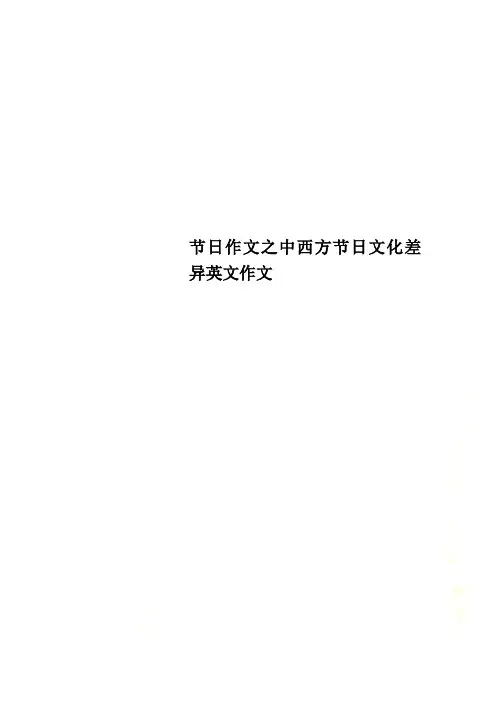
节日作文之中西方节日文化差异英文作文中西方节日文化差异英文作文【篇一:英语论文中西方传统节日文化的差异】culture differences of chinese and western traditionalfestivalabstracttraditional festivals are the historical products of a nation’s development. whether in china which has a long history of more than five thousand years or in the newborn america, the origination of traditional festivals in the two countries is similar. mo st traditional festivals originated from people’s expectation for harvest in the agricultural production, the worship towards the gods and the nature, sacrifices to the historical characters and etc. after the long-term evolution, traditional festivals have become an indispensable part of the national culture. through traditional festivals, the distinct cultural characteristics of a people and the national spirits can be observed. since the ancient time, china has been a large agricultural country, the small-scale economic mode known as ―the men plough and the women weave‖ initiated the agricultural civilization of chinese characteristics. chinese traditional festivals are deeply rooted in the agricultural civilization and greatly influenced by confucianism. to some extent, chinese traditional festivals have relieved from the primitive taboos and tended to be happy festivals which reflect the concept of harmony and integration in confucianism. in america, religion plays a very important role in people’s life. with various branches, the religious system of america is quite complicated, among which christianity is of the greatest importance. some american traditional festivals are the direct products of christianity and most festivals have evolved into the religious festivals later. this paper is designed todiscuss the differences in customs, origins and other aspects of traditional festivals with the similar cultural connotation, then analyze the reasons lying behind the differences and finally reflect the cultural differences of the two nations. the paper also analyzes the mutual fusion in tradtional holidays between china and the west.key words: traditional festivals; chinese and american culture; cultural differences; causes; mutual fusion.中西方传统节日文化的差异摘要传统节日是一个民族发展的历史产物。
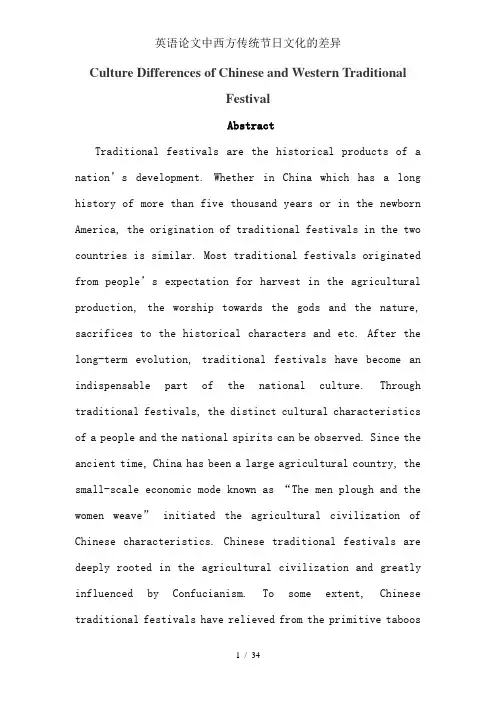
Culture Differences of Chinese and Western TraditionalFestivalAbstractTraditional festivals are the historical products of a nation’s development. Whether in China which has a long history of more than five thousand years or in the newborn America, the origination of traditional festivals in the two countries is similar. Most traditional festivals originated from people’s expectation for harvest in the agricultural production, the worship towards the gods and the nature, sacrifices to the historical characters and etc. After the long-term evolution, traditional festivals have become an indispensable part of the national culture. Through traditional festivals, the distinct cultural characteristics of a people and the national spirits can be observed. Since the ancient time, China has been a large agricultural country, the small-scale economic mode known as “The men plough and the women weave” initiated the agricultural civilization of Chinese characteristics. Chinese traditional festivals are deeply rooted in the agricultural civilization and greatly influenced by Confucianism. To some extent, Chinese traditional festivals have relieved from the primitive taboosand tended to be happy festivals which reflect the concept of harmony and integration in Confucianism. In America, religion plays a very important role in people’s life. With various branches, the religious system of America is quite complicated, among which Christianity is of the greatest importance. Some American traditional festivals are the direct products of Christianity and most festivals have evolved into the religious festivals later. This paper is designed to discuss the differences in customs, origins and other aspects of traditional festivals with the similar cultural connotation, then analyze the reasons lying behind the differences and finally reflect the cultural differences of the two nations. The paper also analyzes the mutual fusion in tradtional holidays between China and the west.Key words: Traditional festivals; Chinese and American culture; cultural differences; causes; mutual fusion.中西方传统节日文化的差异摘要传统节日是一个民族发展的历史产物。
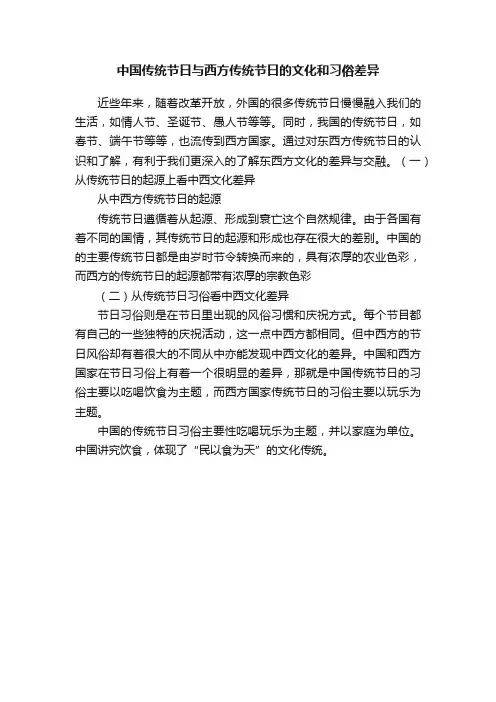
中国传统节日与西方传统节日的文化和习俗差异
近些年来,随着改革开放,外国的很多传统节日慢慢融入我们的生活,如情人节、圣诞节、愚人节等等。
同时,我国的传统节日,如春节、端午节等等,也流传到西方国家。
通过对东西方传统节日的认识和了解,有利于我们更深入的了解东西方文化的差异与交融。
(一)从传统节日的起源上看中西文化差异
从中西方传统节日的起源
传统节日遵循着从起源、形成到衰亡这个自然规律。
由于各国有着不同的国情,其传统节日的起源和形成也存在很大的差别。
中国的的主要传统节日都是由岁时节令转换而来的,具有浓厚的农业色彩,而西方的传统节日的起源都带有浓厚的宗教色彩
(二)从传统节日习俗看中西文化差异
节日习俗则是在节日里出现的风俗习惯和庆祝方式。
每个节目都有自己的一些独特的庆祝活动,这一点中西方都相同。
但中西方的节日风俗却有着很大的不同从中亦能发现中西文化的差异。
中国和西方国家在节日习俗上有着一个很明显的差异,那就是中国传统节日的习俗主要以吃喝饮食为主题,而西方国家传统节日的习俗主要以玩乐为主题。
中国的传统节日习俗主要性吃喝玩乐为主题,并以家庭为单位。
中国讲究饮食,体现了“民以食为天”的文化传统。
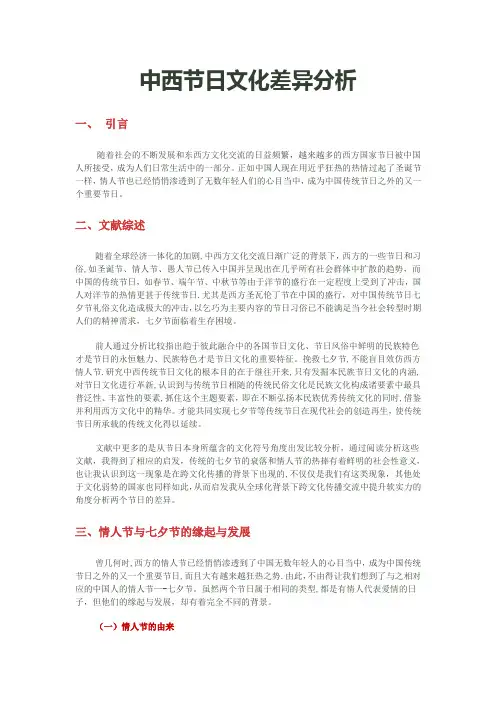
中西节日文化差异分析一、引言随着社会的不断发展和东西方文化交流的日益频繁,越来越多的西方国家节日被中国人所接受,成为人们日常生活中的一部分。
正如中国人现在用近乎狂热的热情过起了圣诞节一样,情人节也已经悄悄渗透到了无数年轻人们的心目当中,成为中国传统节日之外的又一个重要节日。
二、文献综述随着全球经济一体化的加剧,中西方文化交流日渐广泛的背景下,西方的一些节日和习俗,如圣诞节、情人节、愚人节已传入中国并呈现出在几乎所有社会群体中扩散的趋势,而中国的传统节日,如春节、端午节、中秋节等由于洋节的盛行在一定程度上受到了冲击,国人对洋节的热情更甚于传统节日.尤其是西方圣瓦伦丁节在中国的盛行,对中国传统节日七夕节礼俗文化造成极大的冲击,以乞巧为主要内容的节日习俗已不能满足当今社会转型时期人们的精神需求,七夕节面临着生存困境。
前人通过分析比较指出趋于彼此融合中的各国节日文化、节日风俗中鲜明的民族特色才是节日的永恒魅力、民族特色才是节日文化的重要特征。
挽救七夕节,不能盲目效仿西方情人节.研究中西传统节日文化的根本目的在于继往开来,只有发掘本民族节日文化的内涵,对节日文化进行革新,认识到与传统节日相随的传统民俗文化是民族文化构成诸要素中最具普泛性、丰富性的要素,抓住这个主题要素,即在不断弘扬本民族优秀传统文化的同时,借鉴并利用西方文化中的精华。
才能共同实现七夕节等传统节日在现代社会的创造再生,使传统节日所承载的传统文化得以延续。
文献中更多的是从节日本身所蕴含的文化符号角度出发比较分析,通过阅读分析这些文献,我得到了相应的启发,传统的七夕节的衰落和情人节的热捧有着鲜明的社会性意义,也让我认识到这一现象是在跨文化传播的背景下出现的,不仅仅是我们有这类现象,其他处于文化弱势的国家也同样如此,从而启发我从全球化背景下跨文化传播交流中提升软实力的角度分析两个节日的差异。
三、情人节与七夕节的缘起与发展曾几何时,西方的情人节已经悄悄渗透到了中国无数年轻人的心目当中,成为中国传统节日之外的又一个重要节日,而且大有越来越狂热之势.由此,不由得让我们想到了与之相对应的中国人的情人节—-七夕节。
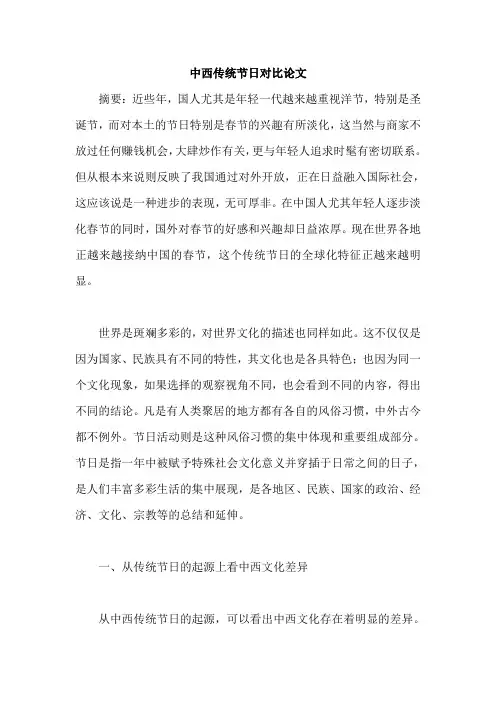
中西传统节日对比论文摘要:近些年,国人尤其是年轻一代越来越重视洋节,特别是圣诞节,而对本土的节日特别是春节的兴趣有所淡化,这当然与商家不放过任何赚钱机会,大肆炒作有关,更与年轻人追求时髦有密切联系。
但从根本来说则反映了我国通过对外开放,正在日益融入国际社会,这应该说是一种进步的表现,无可厚非。
在中国人尤其年轻人逐步淡化春节的同时,国外对春节的好感和兴趣却日益浓厚。
现在世界各地正越来越接纳中国的春节,这个传统节日的全球化特征正越来越明显。
世界是斑斓多彩的,对世界文化的描述也同样如此。
这不仅仅是因为国家、民族具有不同的特性,其文化也是各具特色;也因为同一个文化现象,如果选择的观察视角不同,也会看到不同的内容,得出不同的结论。
凡是有人类聚居的地方都有各自的风俗习惯,中外古今都不例外。
节日活动则是这种风俗习惯的集中体现和重要组成部分。
节日是指一年中被赋予特殊社会文化意义并穿插于日常之间的日子,是人们丰富多彩生活的集中展现,是各地区、民族、国家的政治、经济、文化、宗教等的总结和延伸。
一、从传统节日的起源上看中西文化差异从中西传统节日的起源,可以看出中西文化存在着明显的差异。
传统节日遵循着从起源、形成到衰亡这个自然规律。
由于各国有着不同的国情,其传统节日的起源和形成也存在很大的差别。
中国的主要传统节日都是由岁时节令转换而来的,具有浓厚的农业色彩,而西方的传统节日的起源都带有浓厚的宗教色彩。
中国的主要传统节日都是由岁时节令转换而来的,具有浓厚的农业色彩。
中国长期以来处于封建自给自足的农业社会和自然经济中,其传统节日具有浓厚的农业色彩,包含了农耕文明的社会特征,主要是从岁时节令转换而来的。
我国古代长期以农为本,在生产力和农业技术不发达的情况下,十分重视气候对农作物的影响。
中国的封建社会绵延上千年,男耕女织的农耕生活方式源远流长,农业生产状况、农作物生长情况一直是老百姓心理情绪的晴雨表。
因此,中国传统节庆活动都是依照农历上的节令产生的,人们通过丰收农闲时的这些欢庆活动,祭祀日月星辰,庆祝五谷丰登,祈求来年风调雨顺。
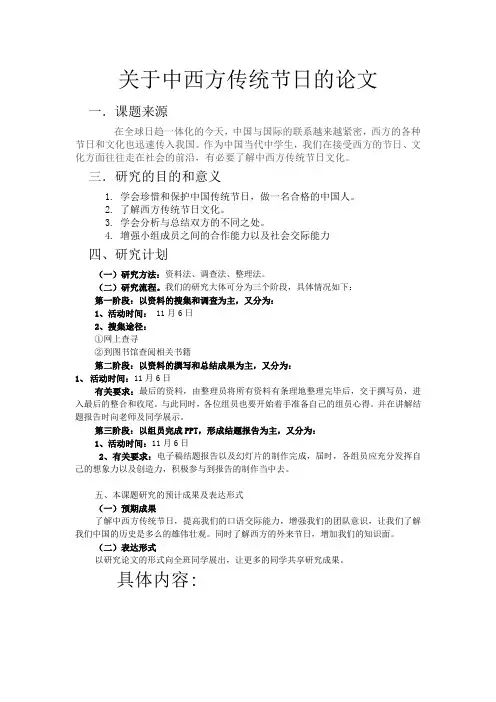
一.课题来源在全球日趋一体化的今天,中国与国际的联系越来越紧密,西方的各种节日和文化也迅速传入我国。
作为中国当代中学生,我们在接受西方的节日、文化方面往往走在社会的前沿,有必要了解中西方传统节日文化。
三.研究的目的和意义1. 学会珍惜和保护中国传统节日,做一名合格的中国人。
2. 了解西方传统节日文化。
3. 学会分析与总结双方的不同之处。
4. 增强小组成员之间的合作能力以及社会交际能力四、研究计划(一)研究方法:资料法、调查法、整理法。
(二)研究流程。
我们的研究大体可分为三个阶段,具体情况如下:第一阶段:以资料的搜集和调查为主,又分为:1、活动时间:11月6日2、搜集途径:①网上查寻②到图书馆查阅相关书籍第二阶段:以资料的撰写和总结成果为主,又分为:1、活动时间:11月6日有关要求:最后的资料,由整理员将所有资料有条理地整理完毕后,交于撰写员,进入最后的整合和收尾。
与此同时,各位组员也要开始着手准备自己的组员心得。
并在讲解结题报告时向老师及同学展示。
第三阶段:以组员完成PPT,形成结题报告为主,又分为:1、活动时间:11月6日2、有关要求:电子稿结题报告以及幻灯片的制作完成,届时,各组员应充分发挥自己的想象力以及创造力,积极参与到报告的制作当中去。
五、本课题研究的预计成果及表达形式(一)预期成果了解中西方传统节日,提高我们的口语交际能力,增强我们的团队意识,让我们了解我们中国的历史是多么的雄伟壮观。
同时了解西方的外来节日,增加我们的知识面。
(二)表达形式以研究论文的形式向全班同学展出,让更多的同学共享研究成果。
具体内容:一.节日“节日”:古代农历的所谓“节”,是对岁时的分节。
把岁时的逐渐变化分成象竹节一样的间距,把两节气交接之日时定为交节,由此转意为节日。
农历上的节日其本意仅指节气的相交之日,并无民俗意义上的节日含义。
在历法所定的年岁、季节交替的节日期间,举行一些约定俗成的活动,在这些活动中,又注入或文化的、或政治的、或经济的内涵,相传相袭,年复一年,从而形成具有完整意义的民俗节日。
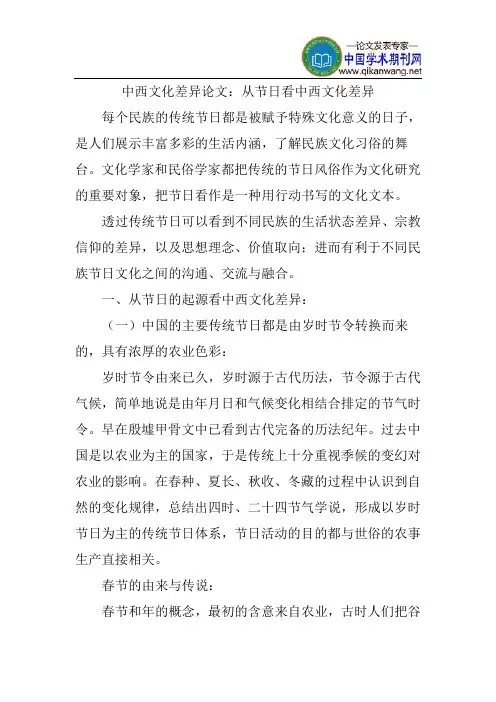
中西文化差异论文:从节日看中西文化差异每个民族的传统节日都是被赋予特殊文化意义的日子,是人们展示丰富多彩的生活内涵,了解民族文化习俗的舞台。
文化学家和民俗学家都把传统的节日风俗作为文化研究的重要对象,把节日看作是一种用行动书写的文化文本。
透过传统节日可以看到不同民族的生活状态差异、宗教信仰的差异,以及思想理念、价值取向;进而有利于不同民族节日文化之间的沟通、交流与融合。
一、从节日的起源看中西文化差异:(一)中国的主要传统节日都是由岁时节令转换而来的,具有浓厚的农业色彩:岁时节令由来已久,岁时源于古代历法,节令源于古代气候,简单地说是由年月日和气候变化相结合排定的节气时令。
早在殷墟甲骨文中已看到古代完备的历法纪年。
过去中国是以农业为主的国家,于是传统上十分重视季候的变幻对农业的影响。
在春种、夏长、秋收、冬藏的过程中认识到自然的变化规律,总结出四时、二十四节气学说,形成以岁时节日为主的传统节日体系,节日活动的目的都与世俗的农事生产直接相关。
春节的由来与传说:春节和年的概念,最初的含意来自农业,古时人们把谷的生长周期称为“年”,《说文禾部》:“年,谷熟也。
”在夏商时代产生了夏历,以月亮圆缺的周期为月,一年划分为十二个月,每月以不见月亮的那天为朔,正月朔日的子时称为岁首,即一年的开始,也叫年。
农历正月初一通常都在立春前后,因而把农历正月初一定为“春节”,俗称阴历年。
(二)西方的传统节日的起源都带有浓厚的宗教色彩:与中国的相比西方的传统节日的起源都带有浓厚的宗教色彩。
自从欧洲大陆被基督教文明浸染后,西方几乎所有影响最大的传统节日都与基督教有关,而且随着基督教跨文明的普世化和欧洲移民向世界各大洲的播散,成为了世界性的节日。
圣诞节的由来:圣诞节是基督教世界最大的节日。
圣诞节是基督徒纪念耶稣诞生的一个重要节日。
根据圣经记载耶稣诞生在犹太的一座小城——伯利恒。
该书记载圣母玛利亚是因圣神的感动而怀孕,就在与丈夫若瑟返往家乡时遇上所有的旅店客满,因此玛利亚被迫在马槽里产下耶稣。
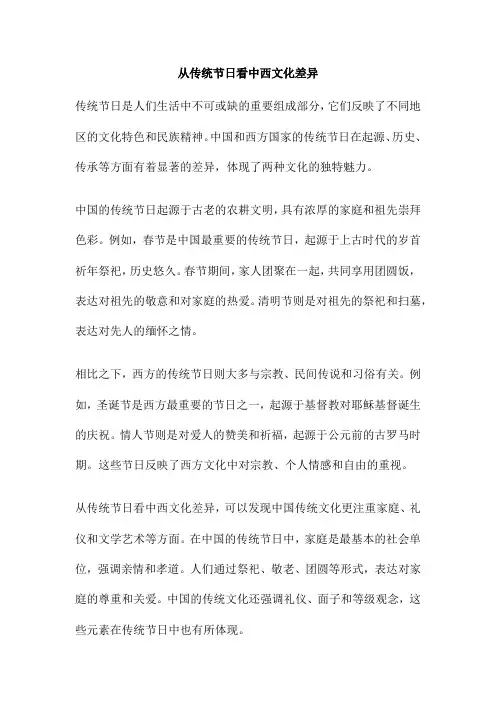
从传统节日看中西文化差异传统节日是人们生活中不可或缺的重要组成部分,它们反映了不同地区的文化特色和民族精神。
中国和西方国家的传统节日在起源、历史、传承等方面有着显著的差异,体现了两种文化的独特魅力。
中国的传统节日起源于古老的农耕文明,具有浓厚的家庭和祖先崇拜色彩。
例如,春节是中国最重要的传统节日,起源于上古时代的岁首祈年祭祀,历史悠久。
春节期间,家人团聚在一起,共同享用团圆饭,表达对祖先的敬意和对家庭的热爱。
清明节则是对祖先的祭祀和扫墓,表达对先人的缅怀之情。
相比之下,西方的传统节日则大多与宗教、民间传说和习俗有关。
例如,圣诞节是西方最重要的节日之一,起源于基督教对耶稣基督诞生的庆祝。
情人节则是对爱人的赞美和祈福,起源于公元前的古罗马时期。
这些节日反映了西方文化中对宗教、个人情感和自由的重视。
从传统节日看中西文化差异,可以发现中国传统文化更注重家庭、礼仪和文学艺术等方面。
在中国的传统节日中,家庭是最基本的社会单位,强调亲情和孝道。
人们通过祭祀、敬老、团圆等形式,表达对家庭的尊重和关爱。
中国的传统文化还强调礼仪、面子和等级观念,这些元素在传统节日中也有所体现。
相比之下,西方文化更注重个人自由、平等和社会责任等方面。
在西方传统节日中,个人情感和自由意志占据主导地位,人们通过庆祝活动表达对个体权利和平等的崇尚。
同时,西方的传统节日也强调社区和群体之间的互动与合作,例如复活节和感恩节等,强调对社会的贡献和责任。
随着全球化的推进,中西文化的差异逐渐缩小,传统节日也在互相影响和融合。
例如,在中国,越来越多的人开始庆祝圣诞节和情人节等西方节日,而在西方国家,也有越来越多的人开始中国的传统节日。
这种文化交流和融合有助于促进不同地区人们之间的相互理解和友谊。
然而,传统与现代的矛盾和融合也在传统节日中得以体现。
在现代社会中,由于生活节奏加快和工作压力增大,人们很难像过去那样全家人团聚在一起庆祝传统节日。
因此,如何将传统与现代相结合,让人们在繁忙的生活中感受到传统节日的氛围和意义,是我们需要思考的问题。
中外节日习俗对比摘要:不同的文化背景孕育了不同民族的节日习俗,虽然中外节日的庆祝方式不同,但所传递的情感与思想大都是相同的,并且各有所长。
了解中外节日的习俗,有助于提升我们对不同民族的信仰及文化的尊重。
关键词:春节与圣诞节、中秋节与感恩节、七夕节与情人节、习俗、对比、引言中国传统文化源远流长、博大精深,可追溯到五千多年前的“三皇五帝”时代,虽经经历多次战乱、历经多次朝代更迭,但汇集了各种民族文化精华的中华文化却从没有中断过,数千年的积累,使中国文化有着深厚的底蕴。
地中海是西方文化的发源地。
西方文化的摇篮是古希腊,古希腊文化以其鲜明的个性和较为成熟的形态傲立于世。
古希腊文化正是在吸纳和借鉴亚非先进文化,在结合本民族的特点的基础上进行的创造。
中国文化有几千年的历史,绵延不断,是世界最古老的文化中,唯一没有中断发展的文化形态。
这样的发展,一方面汇聚了优秀的传统和文化精华,另一方面也积淀了大量的文化糟粕。
西方文化在发展过程中,积极吸取其他文化的丰富营养,在几次断层、中心转移与复兴的过程中,丢弃了许多糟粕和包袱,也去掉了很多束缚与羁绊。
然而无论历史怎样发展,文明怎样进步与完善,人们对节日的尊崇与庆祝都是亘古不变的,所以虽然中西方庆祝节日的方式与习俗大有不同,但是思想与感情都有相通之处。
一、春节和圣诞节的习俗对比春节是我国传统习俗中最隆重的节日。
此节乃一岁之首。
春节一方面是庆贺过去的一年,一方面又祈祝新年快乐、五谷丰登、人畜兴旺,多与农事有关。
迎龙舞龙为取悦龙神保佑,风调雨顺;舞狮源于镇慑糟蹋庄稼、残害人畜之怪兽的传说。
随着社会的发展,接神、敬天等活动已逐渐淘汰,燃鞭炮、贴春联、挂年画、耍龙灯、舞狮子、拜年贺喜等习俗至今仍广为流行。
圣诞节是西方最重要的节日,许多家庭也有在圣诞节前夕进行祈祷、齐唱颂歌的习俗。
人们在圣诞之日汇集到广场,围着在那里的高大圣诞树、齐唱颂歌等活动,还有热闹非凡的圣诞晚会。
西方人以红、绿、白三色为圣诞色,圣诞节来临时家家户户都要用圣诞色来装饰。
中西方节日文化差异英文作文Culture Differences of Chinese and Western TraditionalFestivalAbstractTraditional festivals are the historical products of a nation’s development. Whether in China which has a long history of more than five thousand years or in the newborn America, the origination of traditional festivals in the two countries is similar. Most traditional festivals originated from people’s expectation for harvest in the agricultural production, the worship towards the gods and the nature, sacrifices to the historical characters and etc. After the long-term evolution, traditional festivals have become an indispensable part of the national culture. Through traditional festivals, the distinct cultural characteristics of a people and the national spirits can be observed. Since the ancient time, China has been a large agricultural country, the small-scale economic mode known as ―The men plough and the women weave‖initiated the agriculturalcivilization of Chinese characteristics. Chinese traditional festivals are deeply rooted in the agricultural civilization and greatly influenced by Confucianism. T o some extent, Chinese traditional festivals have relieved from the primitive taboos and tended to be happy festivals which reflect the concept of harmony and integration in Confucianism. In America, religion plays a very important role in people’s life. With various branches, the religious system of America is quite complicated, among which Christianity is of the greatest importance. Some American traditional festivals are the direct products of Christianity and most festivals have evolved into the religious festivals later. This paper is designed to discuss the differences in customs, origins and other aspects of traditional festivals with the similar cultural connotation, then analyze the reasons lying behind the differences and finally reflect the cultural differences of the two nations. The paper also analyzes the mutual fusion in tradtional holidays between China and the west.Key words: Traditional festivals; Chinese and American culture; cultural differences; causes; mutual fusion.中西方传统节日文化的差异摘要传统节日是一个民族发展的历史产物。
近几年来,随着改革开放的不断深入,中西方文化的广泛交流,复活节、感恩节、圣诞节等“洋节”深深地影响了我国的青少年,呈现出传统节日“淡化”的趋势。
2007年,我国将清明节、端午节、中秋节等传统节日定为法定假日,这一举措有效地防止了民族传统文化的流失,政策一出即得到了广大民众的交口称赞。
对于这一现象,有人认为,中国文化源远流长、博大精深,传统节日竟然被西方节日取代,这是对中国文化的践踏,是中华民族的耻辱,应当采取强制措施进行制止。
有人认为,“洋节”代替传统节日是文化发展的必然,是一种优胜劣汰的正常趋势,中国向西方学习,必须容许“洋节”的正常发展。
目前,在对待传统节日与西方“洋节”的问题上,不少人心里存在极大的矛盾。
对于“中国文化与西方文明谁更悠久,谁更值得提倡”这一问题,不易简单地做出回答。
中国文化与西方文明,都是经过许多代劳动人民的勤劳与智慧一点点累积起来的,都是人类文明的宝贵财富。
我认为,“洋节”传到中国是世界文明传播的正常现象,也是我国改革开放的主要成果之一,“洋节”在中国的影响是世界发展的必然。
其实,西方人也正在受着中国文化的熏陶。
人类的文明也正是因为互相影响,相互交融才取得了今天的光辉与灿烂。
在中国,汉民族的文化正是因为经历过历史上无数次的文化交融,不断吸取少数民族文化的精华,博采众家之长,才得以达到今天中华文明的璀璨与辉煌的。
因此,在对待“洋节”的问题上,我们不应恐惧,而应该让东方浑厚的文化与西方浪漫的文化相互交流,让这两种不同风格的文化相互融合,达到完美的结合,化作一座联结东西方文明的文化之桥,让两种文化、不同的文明成为人类共享的财富,最终实现人类文化的再创造、再超越。
“圣诞老人昨夜给我礼物了!”“我也是!”刚到教室,就听见同学们七嘴八舌地讨论着得到的礼物。
我十分无奈,圣诞节不是外国节日吗?中国人为啥要如此热衷?想当初八国联军进攻北京紫禁城,他们烧杀抢掠,一顿狂欢,据说就在圣诞前后三天。
中西方传统节日差异背景:时代在发展,社会在进步。
这是一个文化多元化的时代,古老而深邃的中华文化,源远流长,一脉相传。
在这个社会中,西方文化也很快得渗透到了我们国家,这段时间里,中国境内的文化元素异彩纷呈,各种文化在交流中融合并发展,这无疑是一个好事,因而这些信息也因为全球化的发展而得以传播。
在这样的背景下,我们选择了最具代表性的春节和圣诞节开始进行研究调查。
过程方法:一、中西节日的起源与形成差异中国传统节日的起源: 中国是一个有着古老东方文明的国家。
其悠久的历史和优良传统为传统节日的成长提供了肥沃的土壤。
作为一个农业国,中华文化深深根植于农业。
因此,农业活动使得节日更具有地方性色彩。
春节与一些农业活动,如种植、收获,有着密切的联系。
作为中国最重要的节日,春节的起源可以追溯到几千年来不断进化的一系列丰富多彩的传说和传统。
西方传统节日的起源: 在西方国家,宗教是文化和社会的中心。
人们的思想可以通过宗教来反应。
与此同时,宗教通过人类对上帝或精神的信仰控制着他们。
可以毫不夸张地说,宗教存在于各行各业。
因此,节日与基督教有着密切的联系,除了圣诞节,复活节也与宗教有关。
二、中西节日庆祝方式差异春节作为中国最重要的传统节日, 源于秦朝, 定于每年农历的一月一日, 从农历12月23日开始, 人民开始开展各种庆祝方式, 一直持续到元宵节。
春节的习俗繁多, 如大扫除、吃团圆饭拜年、放鞭炮, 舞狮子等。
总之, 不论是大街小巷, 都笼罩着一股浓浓的喜庆气氛。
而西方, 他们崇尚的是过圣诞节。
相比之下他们过年的方式就浪漫多了, 交换礼物,寄圣诞卡,这都使圣诞节成为了一个普天同庆的日子。
与春节一样圣诞节也表示新的一年即将到来。
12月25日这一天,各教会都会分别举行崇拜仪式。
天主教与东正教举行圣诞弥撤,新教举行圣诞礼拜。
有些教会的庆祝活动从午夜零点就开始。
除崇拜仪式外,还演出圣诞剧,表演耶稣降生的故事。
三、中西方节日文化比较之饮食差异比较国传统节日中的饮食是趋于感性的, 讲究色、香、味俱全。
中外节日对比作文【篇一:中西方节日文化差异比较中英文版】oecd says unemployment will continue to riseoecd:工业化国家失业率持续攀升 despite reports that many industrialized economies are beginning toemerge from their worst economic crisis in decades, unemployment is rising and will likely reach a historic peak of nearly 10 percent next year. the findings come from the organization for economic cooperation and development in paris.经济合作与发展组织星期三报告说,工业化国家的失业率仍在增加,而且有可能在明年达到近10%的历史最高水平,尽管不断有报道说,很多工业化国家正在走出几十年来最严重的经济危机。
indications that unemployment continues to rise is grim news for leaders heading to the g-20 summit in the united statesnext week. the paris-based organization for economic cooperation and development reports unemployment reachedits highest level among industrialized nations of 8.5 percent in july.对于下个星期到美国出席20国集团峰会的各国领导人来说,失业率继续上升真是个坏消息。
A Comparison of Chinese and Western Traditional FestivalsAbstractComparing the Chinese and Western festivals can help people promote the communication and understand the different cultures.As the society and inter-cultures develop,Many aspects of life will be affected by globalization in all countries. And western festivals are becoming more and more popular in China. We should select the essence and discard the dross. China boasts a brilliant history and glorious traditions. In modern times, Chinese tradition should be preserved and promoted. But it seems that young people don’t have the realization to treasure the tradition. To the opposite, they turn to pursue enthusiastically a seemingly more modern culture. If this trend is allowed to continue, the priceless heritage of our ancestors will be replaced by western traditions. There is nobody expecting such a consequence. So let’s unite together to inherit and carry forward Chinese tradition.Key words:traditional festivals; Chinese and Western cultures;cultural differences;common ground中西方传统节日对比研究摘要对比中西方节日可以帮助人们增进交流,了解不同的文化。
随着社会和跨文化的发展,所有国家生活的许多方面都受到全球化的影响。
西方节日在中国正变得越来越流行,我们应该取其精华去其糟粕。
中国有着悠久的历史和光荣的传统。
在当今时代,我们应该继承和发扬中国传统。
但是,年轻人们并没有对待传统的意识,相反,他们转向疯狂地追求更现代的文化。
如果这种趋势一直继续下去,我们祖先无价的遗产将会被西方传统所代替,没有人希望出现那种结果。
所以我们要团结起来继承和发扬中国传统文化。
关键词:传统节日;中西方文化;文化差异;共同点ContentsIntroduction1. Differences of Chinese and Western Traditional Festivals1.1The Difference on the Festival Forms1.2The Difference on the Festival Connotations1.3 The Difference on the Festival Customs1.3.1 Spring Festival vs. Christmas Day1.3.2 Tomb Sweeping Day vs. Halloween1.3.3 Double-Seventh Day vs. Valentines Day1.3.4 Mid-autumn Day vs. Thanksgiving Day2.The Influencing Factors Causing Differences between Chinese and Western Traditional Festivals2.1 Factors Influencing Chinese Traditional Festivals2.1.1 Confucianism2.1.1.1 Benevolence2.1.1.2 Filial Piety and Reunion2.1.2 agriculture civilization2.2 Factors Influencing Western Traditional Festivals3. Common Ground and Mutual Fusion of Chinese and Western Traditional Festivals3.1Common Ground3.2 Mutual Fusion4. ConclusionA Comparison of Chinese and Western Traditional FestivalsIntroductionDifferent countries have different cultures.Culture is the soul carrier of human beings, and it’s the core value of one country. Among all the elements that are composed a nation’s culture, traditional festival culture is the most important and richest one. Festival is regard as a special occasion on which people may give thanks for a harvest, commemorate an honored person or event, pay respect to the dead, or celebrate a culture. Festival introduces during the course of human development and historical evolution as a cultural phenomenon. This remarkable cultural phenomenon reflect human cognition and attention to the natural environments and peripheral surroundings. Festival is viewed as “ a carrier of cult ure”, or an embodiment of the patterns of behavior and thinking that people learn, create and share. Through this unique and specific phenomenon, it is more direct and convenient for the researcher to explore the deeper layer of human culture. Moreover, the festival provides us a shortcut to explore the difference and similarity of two cultures. It is known that Chinese and western traditional festivals are twodifferent cultural forms evolved from comparatively independent cultural systems, which possess peculiar characteristics and varied manifestation. So they must have a lot of differences.The thesis consists of forth parts. The first part would focus on the differences of traditional Chinese and western festivals. In the second part of the thesis, major factors causing differences would be analyzed. The third part would study the common ground and mutual fusion of traditional Chinese and western festivals. In the last part of the thesis, there would be a brief conclusion.1. Differences of Chinese and Western Traditional Festivals1.1 The Difference on the Festival FormsOn the one hand,the influential areas of the two sets of festival cultures are different. Chinese festivals mainly influence the Asian countries including Japan, Korean, Thailand, etc. The western festivals mainly influence the Christian world. Although in the modern multicultural world the influences of western festivals such as Christmas Day are much wider than Chinese Spring Festival, the traditions which have been formed in many countries still exist.On the other hand,they have different periodicity. Chinese traditionalfestivals are mainly based on lunar calendar, while the western ones are mainly based on the solar calendar.1.2 The Difference on the Festival ConnotationsThe first difference in the perspective of connotation is that they have different value orientation. Traditional Chinese festival cultures are featured by collectivism. Chinese festivals attach more importance to group activity and the passing down of ethics and virtues. But traditional western festival cultures are featured by individualism. They lay great emphasis on the expression of personal emotions and the individual psychological feelings.Second, Festivals between China and Western countries are different in the form of emotional expression. Thus, Chinese veil their real thoughts while Westerners always reveal their minds freely and directly. The way of accepting gifts and the attitudes are different. During festivals, the Chinese and the Western country have shown very different attitudes about a gift for someone. The Chinese people often defer about the present, as if they have to accept it, but they will not open it in front of the present. In western country, people ask for a gift, and they will usually open it in front of people’s face and express their thanks.Third, the national culture mentality can also be different. The Chinese festival culture are Comedy-oriented, they pursuit the happyending and harmony, while the western festival culture are tragedy-oriented because the ancient Greek culture are tragic-conscious and the Christian culture are sin conscious.1.3 The Difference on the Festival CustomsThe custom is a great difference between Chinese and western traditional festivals.Different culture background breeds different national festival customs.Understanding Chinese and western festival customs can help us improve our faith and respect to different national culture.Next, in order to study the difference of Chinese and western festival customs,we will take Spring Festival,Tomb Sweeping Day, Double-Seventh Day and Mid-autumn Day for example, and compare with Christmas Day, Halloween, Valentines Day and Thanksgiving Day.1.3.1 Spring Festival vs. Christmas DayIn China, as spring is the most beautiful season and all creatures on earth begin to grow, flowers are blooming in a riot of color; seeds sprout everywhere, i t is vitally important to celebrate the coming of the spring. As the beginning of a year, December 23rd in lunar year is the prelude to Spring Festival. On that day, all families without exception will worship the god of the kitchen and started to busily prepared for the New Year’s coming. In addition, according to the traditional habits, Chinese peoplewill also make a thorough cleanup, which is also called spring-cleaning, to show their desire to sweep “the old and bad things” out of their house, ring out the Old Year and ring in the New Year. After this work, every house along the street has a bright and new look. With paper-cuts on the windows, couplets on the wall and red lanterns in front of the door, it looks really brilliant and full of happiness. The New Year’s Eve is the last day of December in lunar year. At that night, all members in a family will get tog ether to enjoy the “family reunion dinner”, implied meaning lucky and harmony. When having dinner, everyone should only talking about things happy and good, avoid referring to death, disease or something bad. What’s more, family members will not sleep unti l the dawn of the New Year’s Day. Instead, they will chat, watching TV and having snacks such as melon seeds, orange, and peanuts. The most exciting moment is when the New Year’s Bell rang. It seems as if all the firecrackers around the world are set off with only one second. The sound of firecrackers will not stop until the dawn, and the new upsurge will begin at that time, when every family open the door and begin to visit their relatives. The carnival will continue to January 15th in lunar year.In western countries, a similar festival is the Christmas Day which actually begins in December 12th and ends in January 6th in the next year. Like Chinese New Year, it is also a period rather than only one day, which is familiar to us all – December 25th. As the birthday of Jesus Christ, theChristmas Day is with no doubt the most vitally day all over the year. And as we all know, most western people are Christian. Red, green and white are regarded as the luckiest colors in Christmas Day, as they stand for the Christmas candle, Christmas tree and pure snow. People decorate a kind of evergreen tree with all kinds and colors of lights, balloons, gifts, paper flowers and so on, all filled with a festival atmosphere. Santa Claus is the most famous figure in western festival. All children believe that they will receive a brilliant gift from Santa Claus, and as they growing up, they will gradually know that their Santa Claus is a figure in human’s imagination. But who care? The most important thing is they get pleasure and own a happy childhood full of imagine. Just like Chinese spring-dinner, western people value the reunion of the whole family. They having dinner together beside the Christmas tree and enjoy themselves in playing until late at night. It is worth mentioning that the most popular songs during this period are “Silent Night”, “Jingle Bells”.1.3.2 Tomb Sweeping Day vs. HalloweenT he Tomb-sweeping Day is one of the 24 seasonal division points in China, falling on April 4-6 each year. After the festival, the temperature w ill rise up and rainfall increases. It is the high time for spring plowing and sowing. But the Tomb-sweeping Day is not only a seasonal point to guid e farm work; it is more a festival of commemoration. The Tomb-sweepingDay sees a combination of sadness and happiness. This is the most impo rtant day of sacrifice. Both the Han and minority ethnic groups at this tim e offer sacrifices to their ancestors and sweep the tombs of the diseased. Also, they will not cook on this day and only cold food is served. In ancie nt times, people celebrated the Tomb-sweeping Day with dancing, singing , picnics, and kite flying. Colored boiled eggs would be broken to symbol ize the opening of life. In the capital, the Emperor would plant trees on th e palace grounds to celebrate the renewing nature of spring. In the village s, young men and women would court each other.Similar to the spring festivals of other cultures, Tomb Sweeping Da y celebrates the rebirth of nature, while marking the beginning of the plan ting season and other outdoor activities. On each Tomb-sweeping Day, al l cemeteries are crowded with people who came to sweep tombs and offer sacrifices. Traffic on the way to the cemeteries becomes extremely jamm ed. The customs have been greatly simplified today. After slightly sweepi ng the tombs, people offer food, flowers and favorites of the dead, then b urn incense and paper money and bow before the memorial tablet. With t he passing of time, this celebration of life became a day to the honor past ancestors. Following folk religion, the Chinese believed that the spirits of deceased ancestors looked after the family. Sacrifices of food and spirit m oney could keep them happy, and the family would prosper through good harvests and more children.Today, Chinese visit their family graves to tend to any underbrush th at has grown. Weeds are pulled, and dirt swept away, and the family will s et out offerings of food and spirit money. Unlike the sacrifices at a family' s home altar, the offerings at the tomb usually consist of dry, bland food. One theory is that since any number of ghosts roam around a grave area, t he less appealing food will be consumed by the ancestors, and not be plun dered by strangers. Honoring ancestors begins with proper positioning of a gravesite and coffin. Experts in Fang Shri, or geomancy, determine the quality of land by the surrounding aspects of streams, rivers, trees, hills, a nd so forth. An area that faces south, with groves of pine trees creates the best flow of cosmic energy required to keep ancestors happy. Unfortunate ly, nowadays, with China's burgeoning population, public cemeteries hav e quickly supplanted private gravesites. Family elders will visit the graves ite at least once a year to tend to the tombs. While bland food is placed b y the tombs on the Tomb-sweeping Day, the Chinese regularly provide sc rumptious offerings to their ancestors at altar tables in their homes. The fo od usually consists of chicken, eggs, or other dishes a deceased ancestor was fond of. Accompanied by rice, the dishes and eating utensils are caref ully arranged so as to bring good luck. In some parts of China, the food i s then eaten by the entire family.In contrast to the sadness of the tomb sweepers, people also enjoy ho pe of spring on this day. The Tomb-sweeping Day is a time when the sunshines brightly, the trees and grass become green and nature is again livel y. Since ancient times, people have followed the custom of spring outings . At this time tourists are everywhere. People love to fly kites during the T omb-sweeping Day. Kite flying is actually not limited to the Tomb-sweep ing Day. Its uniqueness lies in that people fly kites not during the day, but also at night. A string of little lanterns tied onto the kite or the thread loo k like shining stars, and therefore, are called "god's lanterns." The Tomb-s weeping Day is also a time to plant trees, for the survival rate of saplings is high and trees grow fast later. In the past, the Tomb-sweeping Day was called "Arbor Day".In western countries, a similar festival is Halloween.On October 31st, dozens of children dressed in costumes knock on their neighbors' doors and yell "Trick or Treat" when the door opens. Pirates and princesses, ghosts and popular heroes of the day all hold bags open to catch the candy or other goodies that the neighbors drop in. As they give each child a treat the neighbors exclaim over the costumes and try to guess who is under the masks.Since the 800's November 1st is a religious holiday known as All Saints' Day. The Mass that was said on this day was called Allhallowmas. The evening before became known as All Hakka e'en, or Halloween. Like some other American celebrations, its origins lie in both pre-Christian and Christian customs.October 31 st was the eve of the Celtic new year. TheCelts were the ancestors of the present-day Irish, Welsh and Scottish people. On this day ghosts walked and mingled with the living, or so the Celts thought. The townspeople baked food all that day and when night fell they dressed up and tried to resemble the souls of the dead. Hoping that the ghosts would leave peacefully before midnight of the new year.Much later, when Christianity spread throughout Ireland and October 31 was no longer the last day of the year, Halloween became a celebration mostly for children. "Ghosts" went from door to door asking for treats, or else a trick would be played on the owners of the house. When millions of Irish people immigrated to the United States in the 1840s the tradition came with them.Today' school dances and neighborhood parties called "block parties" are popular among young and old alike. More and more adults celebrate Halloween. They dress up like historical or political figures and go to masquerade parties. In larger cities, costumed children and their parents gather at shopping malls early in the evening. Stores and businesses give parties with games and treats for the children.Teenagers enjoy costume dances at their schools and the more outrageous the costume the better!Certain pranks such as soaping car windows and tipping over garbage cans are expected. But partying and pranks are not the only things that Halloween-ers enjoy doing. Some collect money to buy food and medicine for needy children around the world.Halloween originated as a celebration connected with evil spirits. Witches flying on broomsticks with black cats, ghosts, goblins and skeletons have all evolved as symbols of Halloween. They are popular trick-or-treat costumes and decorations for greeting cards and windows. Black is one of the traditional Halloween colors, probably because Halloween festivals and traditions took place at night. In the weeks before October 31, Americans decorate windows of houses and schools with silhouettes of witches and black cats.Pumpkins are also a symbol of Halloween. The pumpkin is an orange-colored squash, and orange has become the other traditional Halloween color.1.3.3 Double-Seventh Day vs. Valentines DayThe seventh day of the seventh lunar month is the most romantic traditional Chinese festival, commonly known as the double-Seventh Festival,the Begging Festival or the Daughter’s Festival.Skills-begging is he main folk custom for the Double-Seventh Festival, on which night women would get together to pray to Vega and Altair. Zhi Nu is said to be clever and deft, good at handicraft, so women always pray to her for the special gift, which is called skills-begging. There are also those who pray for wealth, long life or sons, each having her own preferable choice, but only one wish can be prayed for accordingto the folk belief. As the folktale goes, Zhi Nu is a wretched maid , nothing but clever and deft; there fore more women tend to pray for her special gift.The sacrifice offered to Niu Lang and Zhi Nu are distinctive-melons, flowers, water chestnuts, peaches, plums, lotus seedpods, etc.-----fresh and dainty, in remarkable contrast to the usual fish and meat offered at those common memorial ceremonies hosted by male masters.Skill-begging takes varied forms; the common one is threading the needle. A group of unmarried girls, with threads in hand, perform a small contest of threading the needle in the moonlight and the one who first threads the needle will win the special gift from Zhi Nu. It is a very popular game among maids. There is a story about a maid named Zheng Cainiang who prayed to Vega on the night of the Double-seventh Festival. Zhi Nu asked her what she desired and she answered “weaving crafts”. Zhi Nu then gave her a one-inch gold needle and stuck it in a piece of paper, saying that within three days without letting anybody know Zhen Cainiang would receive the special gift and could also change into a lad. Two days later, Zheng Cainiang could not help but reveal the secret to her mother who went to see the gold needle out of curiosity, only to find nothing but the paper with the needle hole in it. After her death, Zheng Caining was said to be reincarnated to a baby boy. Afterwards, maids followed suit and thus threading the needle to beg for the special gift has become a popular practice.One of the anecdotes kept in the book Kaiyuan Tianbao Yishi [Bequeathed Matters from the Kaiyuan (713AD---741AD) and Tianbao (742 AD---756AD) Periods],about the time of Emperor Tang Xuanzong of the Tang Dynasty (618AD---907AD), mentions that there was another form of “skills-begging”in the palace at that time: On the night of the Double-Seventh Festival, the palace maids would each get a spider, put it into a small box, and open the box the next early morning to see whose spider had woven a thicker web; the thicker web showed the owner’s being bestowed on more weaving skills, the thinner fewer. Accordingly, the folk populace contended to take the practice, which was of great appeal.In the south area by the Chang Jiang River, according to the memories of the elderly women, the begging activity in their childhood had a different aspect of interest. Early on the day before the double-seventh’s festival, people would fetch rainwater and well-water in equal quantity and put the mixed water and well-water in equal quantity and put the mixed water in a bowl in the open air for a whole night. The next morning on the Double-Seventh Festival, the bowl of water which contained night dew too would be put under the sun for half a day till the noon when a thin film emerged on the surface of the water. Then an embroidery needle, or an extremely thin bamboo strand, or a pine needle would be put on the surface slightly enough that it would float but notsink. Judgment would be made according to the needle shadows reflected from the bottom of the water. Due to accidental factors, coupled with people’s imagination, the needle shadows would change constantly and magically. It was taken for granted that the form of a dragon, a phoenix, or clouds or flowers was a sign of receiving the special gift, a prediction that the girl would be clever and deft and get whatever she aspired after. Such an activity was always performed when lots of girls gathered together, known as “the Begging Gathering”, which was full of delightful laughter and cheerful exchanges of conversations.Among the folk populace in Guangzhou, while worshiping on the night of the Double-Seventh Festival, girls will display their own needlework on the offering table, such as their hand-made embroidered shoes, tiger-head hats, scented purses, paper-cuts and many other articles of handicraft art, which is a feast for the eyes, too much to enjoy. Friends, relatives and passers-by cannot help stopping to appreciate and comment.In some areas, there is a custom of gazing up at clouds on the Double-Seventh Festival. People presume that day’s clouds tend to take special magic changing forms and they like to conjecture about their fates in accordance with the changeable clouds. This seems somewhat mysterious as the above-mentioned needle shadows, under the influence exerted by people’s psychology. The elderly in the countryside are said to observe the Heavenly River whose early appearance is said to predict aharvest year with a low corn price; otherwise, a high corn price. People call it “An Inquiry about Corn Price”, an old practice of divination, which so far has faded out of people’s memory.The country girls in the south of the Changjiang River have the custom of washing hair on the Double-Seventh Festival. Originally, they went to the field to collect seven kinds of weeds from which they rubbed juice out for hair washing. Later, hair was washed with water mixed with hibiscus leaves to substitute for weeds. It is said that Zhi Nu will wash her hair by the riverside that day and go to meet Niu Lang when her hair takes a glossy black look. Thus girls on the earth wash their hair too on that day.We cannot miss mentioning one snack for the festival . Dough is mixed with sugar, kneaded, pressed into a thin piece, cut into small squares, twisted slightly and put into boiled oil resembles Mahua( a fried dough twist), but more dainty and has a nice name “Qiao Guo”with the implication of “skills-begging”. It is usually home-made; some stores run this business as well and it sells well.Till now, the begging mores on the Double-Seventh Festival seem to fade out, but the legend of NiLang and Zhi Nu is still on the lips of people. Since Valentine’s Day is celebrated in foreign countries, some say, the Chinese should observe their own Valentine’s Day too. Among the traditional festivals, the Double-Seventh Festival is better suited to Valentine’s Day. Won’t you agree?In western countries, Valentine's Day is an informal observance of a lover's holiday. Today, the observance has no connection with the many legendary Valentines, and holds no religious significance. The day is observed with exchanges of love notes and cards, and other tokens of affection, called valentines. The symbols of the heart and Cupid are common in cards, decorations of store windows,candies and other paraphernalia. Traditional valentines were frilly sweet, and tender affairs made of red and white paper and lace with cutouts and cupids. The custom of sending cards, giving candy, and other such tokens has caught a great deal of commercial enthusiasm. Many stores, for instance, decorate seasonally, or a according to calendar holidays. Valentine's Day is the first excuse for splashy valentine theme dominates stationery stores, candy stores, confectioneries and quite often drug stores where cards and candy are sold.1.3.4 Mid-autumn Day vs. Thanksgiving Day"Zhong Qiu Jie" which is also known as the Mid-Autumn Festival, is celebrated on the 15th day of the 8th month of the lunar calendar in China. This day is considered a harvest festival since fruits, vegetables an d grain has been harvested by this time and food is abundant. So, it is a ti me for relaxation and celebration. Food offerings are placed on an altar set up in the courtyard. Apples, pears, peaches, grapes, pomegranates, melo ns, oranges and pomelos might be seen. Special foods for the festival incl ude moon cakes, cooked taro, edible snails from the taro patches and wate r caltrop.The round moon cakes, measuring about three inches in diameter an d one and a half inches in thickness, resemble Western fruitcakes in taste and consistency. These cakes are made with melon seeds, almonds, mince d meats, bean paste and so on. A golden yolk from a salted duck egg is pl aced at the center of each cake, and the golden brown crust is decorated w ith symbols of the festival.Today, festivities centered about the Mid-Autumn Festival are more varied. After a family reunion dinner, many people like to go out to attend special performances in parks or on public squares. What’s more,people in different parts of China have different ways to celebrate the Mid-Autumn Festival.For example, in Guangzhou in South China, a huge lantern show is a big attraction for local citizens. Thousands of differently shaped lanterns are lit, forming a fantastic contrast with the bright moonlight.Though people in different places follow various custo ms, but all show their love and longing for a better life.In western countries, Thanksgiving Day, legal holiday observed annually in the United States on the fourth Thursday of November. InCanada, Thanksgiving falls on the second Monday in October. Today Thanksgiving is mainly a celebration of domestic life, centered on the home and family.Public observances of Thanksgiving usually emphasize the holiday's connection with the Pilgrims. Thanksgiving pageants and parades often feature children dressed in Pilgrim costume, complete with bonnets or tall hats, dark clothes, and shoes with large silver-colored buckles.Many of the images commonly associated with Thanksgiving are derived from much older traditions of celebrating the autumn harvest. For example, the cornucopia (a horn-shaped basket overflowing with fruits and vegetables) is a typical emblem of Thanksgiving abundance that dates to ancient harvest festivals. Many communities also decorate their churches with fruits, flowers, and vegetables at Thanksgiving, much as European communities have for centuries during the autumn harvest season.In keeping with the idea of celebrating a plentiful harvest, preparing and eating a large meal is a central part of most Thanksgiving celebrations. pumpkin pie. These simple foods recall the rustic virtues of the Pilgrims. emphasizing the natural bounty that greeted early settlers in their adopted homeland. Later groups of immigrants to North America often adapted the traditional holiday menu to fit their own tastes. For example, many Italian American Thanksgiving meals include Italian specialties, such as pasta and wine.Many Americans digest their holiday meal while watching。